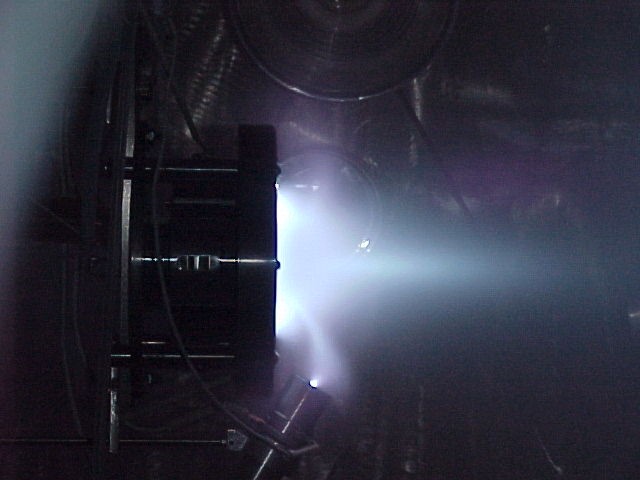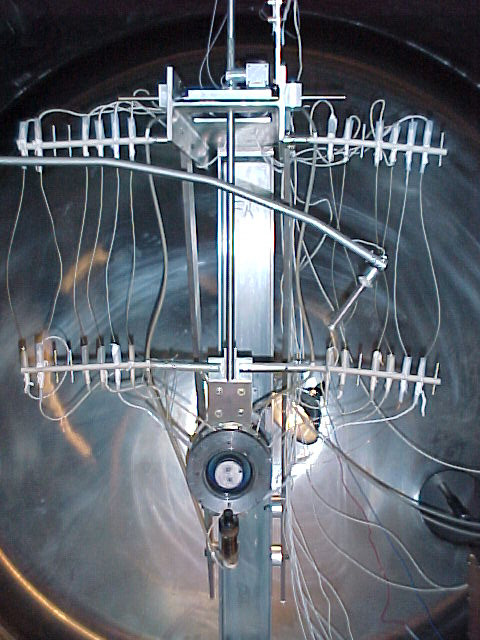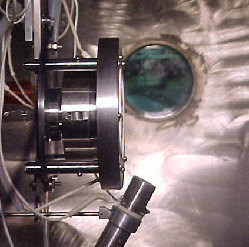|
Plasma Thruster Physics

The Hall thruster is an electric
rocket engine, which accelerats ions in crossed electric and magnetic fields
in a quasineutral plasma.
The PPPL Hall Thruster Experiment
(HTEX) seeks to develop more efficient Hall thrusters for various
space applications through better understanding of the physical processes
involved in thruster operation.
|
Members of the Hall
Thruster Project
|
| Research Staff: |
Professor Nathaniel
J. Fisch (Project Head)
Dr. Yevgeny Raitses |
| Graduate Students: |
Iliya Dodin
Leonid Dorf
Andrei Litvak |
| Undergraduate Students: |
Kevin M. Ertmer
Kai-Mei C. Fu
Eugenio Ortiz |
| Technical Support: |
Richard Yager |
| Collaborators: |
Professor Amnon Fruchtman,
Center for Technological Education,
Holon, Israel
Vlad Soukhanovskii
Dr. Daniel Stutman
Johns Hopkins University |
Research Objectives:
-
Control of spatial distribution
of plasma parameters by using segmented electrodes in order to reduce beam
divergence in the thruster channel and plume.
-
Scaling of Hall thrusters to
low (tens W) and high power (tens kW) levels.
-
Control of plasma instabilities
in crossed field plasma devices.
-
Limitations of magnetic insulation
in plasmas with magnetized electrons and non- magnetized ions.
-
Interaction of high flux plasma
jets with different targets (magnetic field, plasma and solid)
-
Exploring of new configurations
of crossed field plasma devices for space, scientific and industrial applications.
-
Steady state electrical discharge
in crossed field devices under various pressures and gases.

Related Publications
Design and Operation of Hall
Thruster with Segmented Electrodes,
N. J. Fisch, Y. Raitses,
A. Litvak, and L. Dorf,
AIAA Paper No. 99-2572,
34th AIAA/ASME/SAE/ASEE
Joint Propulsion Conference,
(June, 1999). WORD
Facility:
A. Test
-
A 28 cub.m stainless steel vacuum
vessel equiped with a 50,000 l/s (for air) pumping system.
-
A 0.3 cub.m vacuum chamber equiped
with 1500 l/s turbo pump.
-
A few small vacuum chambers
for different plasma experiments.
-
Commercial voltage and current
regulated power supplies (up to 1 kW and 10 kW)
-
Commercial gas flow control
and measurement systems.
B. Diagnostics
-
A high resolution thrust stand
-
Electrostatic probes and energy
analyzer
-
Emissive spectroscopy
-
Digital and analog scopes and
analysers
The first laboratory Hall thruster
was developed and built in February of 1999. The thruster was designed
to work at 1 kW power range by a linear scaling of its geometry relative
to a subkilowatt Soreq Hall thruster. However, it has a magnetic circuit
configuration different form conventional Hall thrusters in order to be
able to work at 2 kW power levels and even higher. The first thruster start
took place in March of 1999. Since then, the PPPL laboratory thruster has
accumulated about 100 hours of operation, during the PPPL laboratory thruster
has demonstrated the ability to achieve the-state-of the-art performance.
Present Theoretical and
Experimental Studies:
-
The effect of segmented electrodes
and their materials on ionization and acceleration processes in the laboratory
Hall thruster at different power levels.

-
The use of emissive spectroscopy
for measurements of plasma properties inside and outside the thruster and
for indirect characterization of the beam divergence inside the thruster
channel.
-
Scaling of Hall thruster geometry
versus input power.
-
Control of the location of a
sonic transition point in Hall thrusters and its effect on thruster performance.
-
Hall effect plasma acceleration
in coaxial and non-coaxial configurations of cross-field devices.
-
A breakdown and conditions for
a steady-state electrical discharge in a crossed magnetic field with electronegative
gases.
-
Creation of magnetosphere storms.
Development Activities:
-
Modifications of configuration
and materials of the segmented electrodes in a 2 kW Hall thruster.
-
Micro Hall thrusters of coaxial
and non-coaxial configurations.
-
A probe setup for measurements
of spatial distribution of plasma parameters inside the Hall thruster channel.
-
A thrust stand and diagnostic
for a micro thruster characterization experiments.
-
An experimental setup for investigation
of interaction of a high flux plasma jet with magnetic dipole.
-
A plasma source for plasma etching.
Email Nathaniel
Fisch or Yevgeny Raitses for
more information on the Hall Thruster Project.
| Back
|
|

